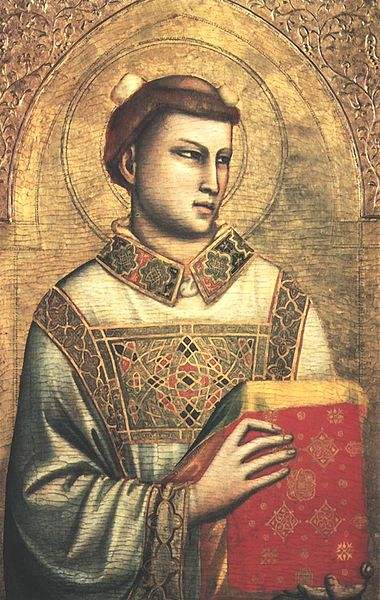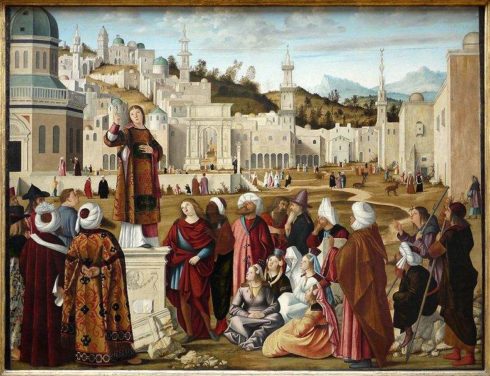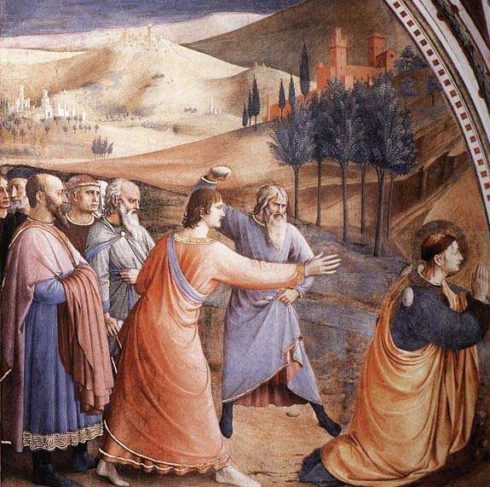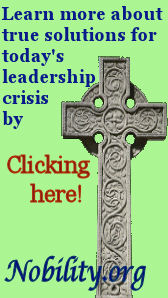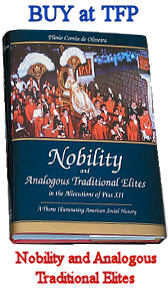St. Stephen
One of the first deacons and the first Christian martyr; feast on 26 December. In the Acts of the Apostles the name of St. Stephen occurs for the first time on the occasion of the appointment of the first deacons (Acts, vi, 5). Dissatisfaction concerning the distribution of alms from the community’s fund having arisen in the Church, seven men were selected and specially ordained by the Apostles to take care of the temporal relief of the poorer members. Of these seven, Stephen, is the first mentioned and the best known.
Stephen’s life previous to this appointment remains for us almost entirely in the dark. His name is Greek and suggests he was a Hellenist, i.e., one of those Jews who had been born in some foreign land and whose native tongue was Greek; however, according to a fifth century tradition, the name Stephanos was only a Greek equivalent for the Aramaic Kelil (Syr. kelila, crown), which may be the protomartyr’s original name and was inscribed on a slab found in his tomb. It seems that Stephen was not a proselyte, for the fact that Nicolas is the only one of the seven designated as such makes it almost certain that the others were Jews by birth. That Stephen was a pupil of Gamaliel is sometimes inferred from his able defence before the Sanhedrin; but this has not been proved. Neither do we know when and in what circumstances he became a Christian; it is doubtful whether the statement of St. Epiphanius (Haer., xx, 4) numbering Stephen among the seventy disciples is deserving of any credence. His ministry as deacon appears to have been mostly among the Hellenist converts with whom the Apostles were at first less familiar; and the fact that the opposition he met with sprang up in the synagogues of the “Libertines” (probably the children of Jews taken captive to Rome by Pompey in 63 B. C. and freed hence the name Libertini), and “of the Cyrenians, and of the Alexandrians, and of them that were of Cilicia and Asia” shows that he usually preached among the Hellenist Jews. That he was pre eminently fitted for that work, his abilities and character, which the author of the Acts dwells upon so fervently, are the best indication. The Church had, by selecting him for a deacon, publicly acknowledged him as a man “of good reputation, full of the Holy Ghost and wisdom” (Acts, vi, 3). He was “a man full of faith, and of the Holy Ghost” (vi, 5), “full of grace and fortitude” (vi, 8); his uncommon oratorical powers and unimpeachable logic no one was able to resist, so much so that to his arguments replete with the Divine energy of the Scriptural authorities God added the weight of “great wonders and signs” (vi, 8). Great as was the efficacy of “the wisdom and the spirit that spoke” (vi, 10), still it could not bend the minds of the unwilling; to these the forceful preacher was fatally soon to become an enemy.
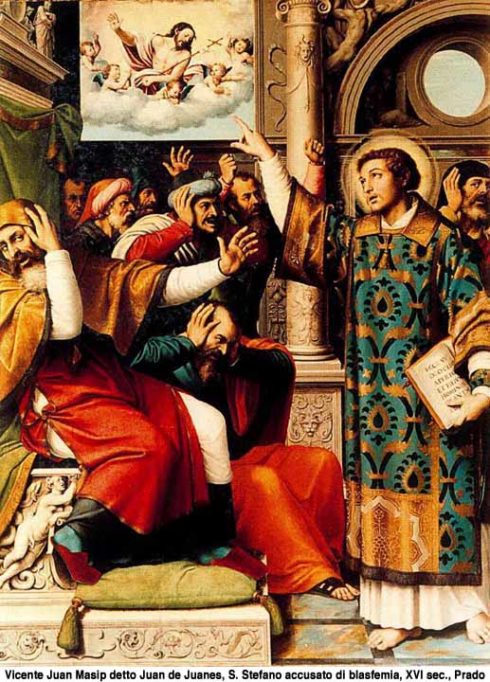 The conflict broke out when the cavillers of the synagogues “of the Libertines, and of the Cyreneans, and of the Alexandrians, and of them that were of Cilicia and Asia”, who had challenged Stephen to a dispute, came out completely discomfited (vi, 9 10); wounded pride so inflamed their hatred that they suborned false witnesses to testify that “they had heard him speak words of blasphemy against Moses and against God” (vi, 11).
The conflict broke out when the cavillers of the synagogues “of the Libertines, and of the Cyreneans, and of the Alexandrians, and of them that were of Cilicia and Asia”, who had challenged Stephen to a dispute, came out completely discomfited (vi, 9 10); wounded pride so inflamed their hatred that they suborned false witnesses to testify that “they had heard him speak words of blasphemy against Moses and against God” (vi, 11).
No charge could be more apt to rouse the mob; the anger of the ancients and the scribes had been already kindled from the first reports of the preaching of the Apostles. Stephen was arrested, not without some violence it seems (the Greek word synerpasan implies so much), and dragged before the Sanhedrin, where he was accused of saying that “Jesus of Nazareth shall destroy this place [the temple], and shall change the traditions which Moses delivered unto us” (vi, 12 14). No doubt Stephen had by his language given some grounds for the accusation; his accusers apparently twisted into the offensive utterance attributed to him a declaration that “the most High dwelleth not in houses made by hands” (vii, 48), some mention of Jesus foretelling the destruction of the Temple and some inveighing against the burthensome traditions fencing about the Law, or rather the asseveration so often repeated by the Apostles that “there is no salvation in any other” (cf. iv, 12) the Law not excluded but Jesus. However this may be, the accusation left him unperturbed and “all that sat in the council…saw his face as if it had been the face of an angel” (vi, 15).
Stephen’s answer (Acts, vii) was a long recital of the mercies of God towards Israel during its long history and of the ungratefulness by which, throughout, Israel repaid these mercies. This discourse contained many things unpleasant to Jewish ears; but the concluding indictment for having betrayed and murdered the Just One whose coming the Prophets had foretold, provoked the rage of an audience made up not of judges, but of foes. When Stephen “looking up steadfastly to heaven, saw the glory of God, and Jesus standing on the right hand of God”, and said: “Behold, I see the heavens opened, and the Son of man standing on the right hand of God” (vii, 55), they ran violently upon him (vii, 56) and cast him out of the city to stone him to death. Stephen’s stoning does not appear in the narrative of the Acts as a deed of mob violence; it must have been looked upon by those who took part in it as the carrying out of the law. According to law (Lev., xxiv, 14), or at least its usual interpretation, Stephen had been taken out of the city; custom required that the person to be stoned be placed on an elevation from whence with his hands bound he was to be thrown down. It was most likely while these preparations were going on that, “falling on his knees, he cried with a loud voice, saying: “Lord, lay not this sin to their charge” (vii, 59). Meanwhile the witnesses, whose hands must be first on the person condemned by their testimony (Deut., xvii, 7), were laying down their garments at the feet of Saul, that they might be more ready for the task devolved upon them (vii, 57). The praying martyr was thrown down; and while the witnesses were thrusting upon him “a stone as much as two men could carry”, he was heard to utter this supreme prayer: “Lord Jesus, receive my spirit” (vii, 58). Little did all the people present, casting stones upon him, realize that the blood they shed was the first seed of a harvest that was to cover the world.
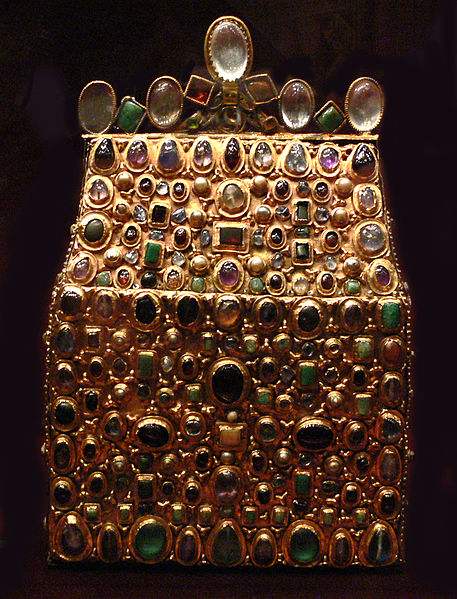
St. Stephan’s Purse, also Stephansburse, is part of the Crown Jewels of the Holy Roman Empire. It is a reliquary in the form of a pilgrim’s bag that contains earth from Jerusalem, which is soaked with the blood of St. Stephen.
The bodies of men stoned to death were to be buried in a place appointed by the Sanhedrin. Whether in this instance the Sanhedrin insisted on its right cannot be affirmed; at any rate, “devout men” whether Christians or Jews, we are not told “took order for Stephen’s funeral, and made great mourning over him” (vii, 2). For centuries the location of St. Stephen’s tomb was lost sight of, until (415) a certain priest named Lucian learned by revelation that the sacred body was in Caphar Gamala, some distance to the north of Jerusalem. The relics were then exhumed and carried first to the church of Mount Sion, then, in 460, to the basilica erected by Eudocia outside the Damascus Gate, on the spot where, according to tradition, the stoning had taken place (the opinion that the scene of St. Stephen’s martyrdom was east of Jerusalem, near the Gate called since St. Stephen’s Gate, is unheard of until the twelfth century). The site of the Eudocian basilica was identified some twenty years ago, and a new edifice has been erected on the old foundations by the Dominican Fathers.
The only first hand source of information on the life and death of St. Stephen is the Acts of the Apostles (vi, i viii, 2).
CHARLES L. SOUVAY (Catholic Encyclopedia)
